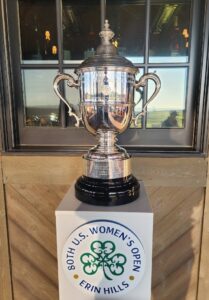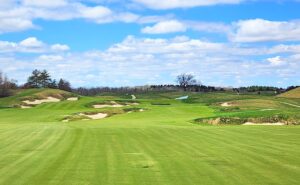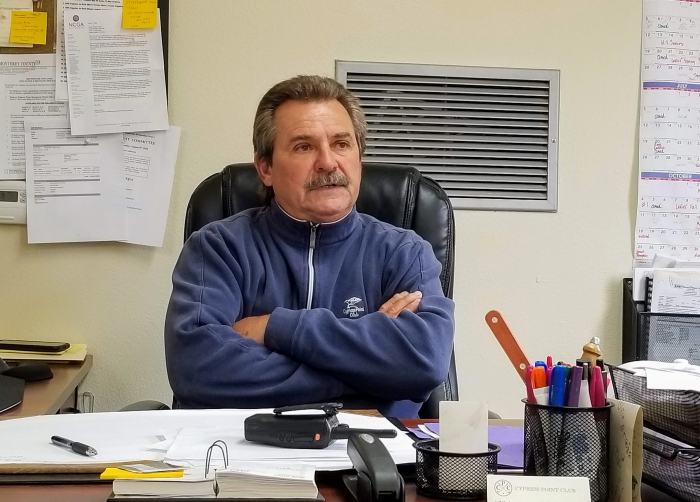
Jeff Markow CGCS at Cypress Point Club in Monterey, California. In 2020 we’ve all experienced a new normal, one we’d just as soon like to forget, but one of the highlights for us was spending a day talking with the one and only – Jeff Markow at Cypress Point. To say that Markow has the finest office on earth is pretty much a tap-in. Always ranked among the top two or three venues in the world, just being on the property is a thrill. For this Q&A I brought along one of the most respected minds in golf architecture (and someone I’m proud to call a friend) – Jay Blasi. Two minds are always better than one when attempting to glean the wisdom and trade secrets of a turf master like Markow.
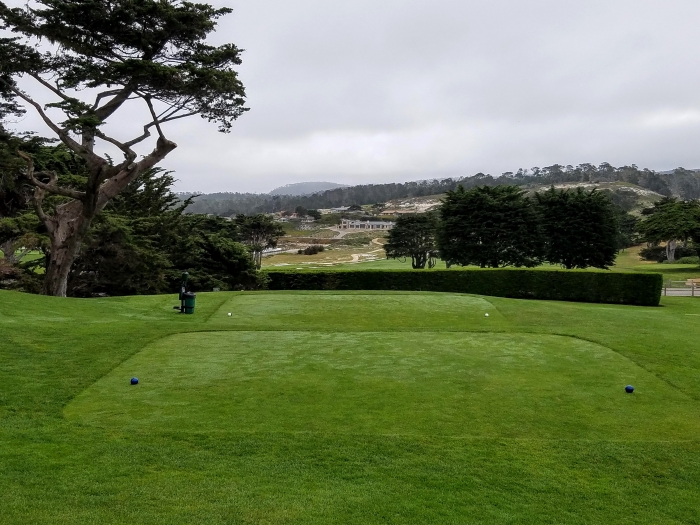
1st tee Cypress Point
Jeff Markow is a mid-west native (Minnesota) transplanted in the golden state, working the land along the coastline of visionaries – Samuel Morse, MacKenzie and Marion Hollins. He’s another agronomy guru from the long lineage of highly successful Penn State Nittany Lions in the turf industry. Markow commands a room like few others and carries the responsibility of tending to Mother Nature’s Mona Lisa with deference. When I spoke to other agronomy leaders about Markow, I heard similar remarks like this from Olympic Club’s Troy Flanagan, “He has been such a positive mentor for me and countless others, so helpful for my career. I wouldn’t be where I am today without Jeff.”
We hope you enjoy our back and forth with Jeff Markow, I know Blasi and I did.
LinksNation (Bruno): When did you come to Cypress Point Club ?
Jeff Markow: 1993, Almost 28 years now. I was down in the desert (Palm Springs) for about 8 years before arriving here. Minnesota was great but career movement up there was limited. Somebody would have to move or retire, so as a young person trying to get started, I had a lot of friends and colleagues who had moved out to the desert from Minnesota. In fact, my superintendent who was probably one of my biggest mentors that got me into the business went to the desert at the same time.
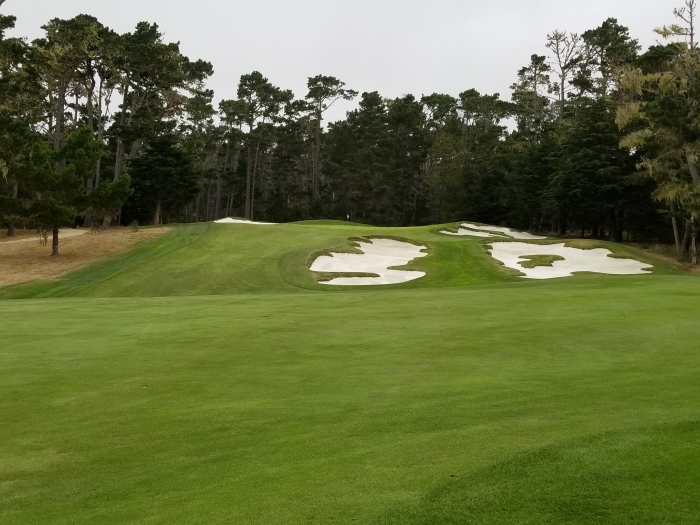
CPC 5th fairway
LN (Bruno): Who were some of those mentors?
Markow: There were so many, I’d hate to leave somebody out. At school (Penn state) it was Dr. Joseph Duich, he was great. There were lots of life lessons too. We had an etiquette class on how to set a table, “he said, ‘you guys are going to sit down in a boardroom with a bunch of important people, you need to learn these things. You’ll learn the turf side, but you need to learn some life stuff.’ “
Mark Smith was also a mentor, he was a Superintendent at Minneapolis Golf Club and gave me a shot, coming from a little golf course in Mankato while I was attending the University of Minnesota. “He said, ‘why don’t you get into this business, so he helped me get into Penn State (Agronomy).’ “
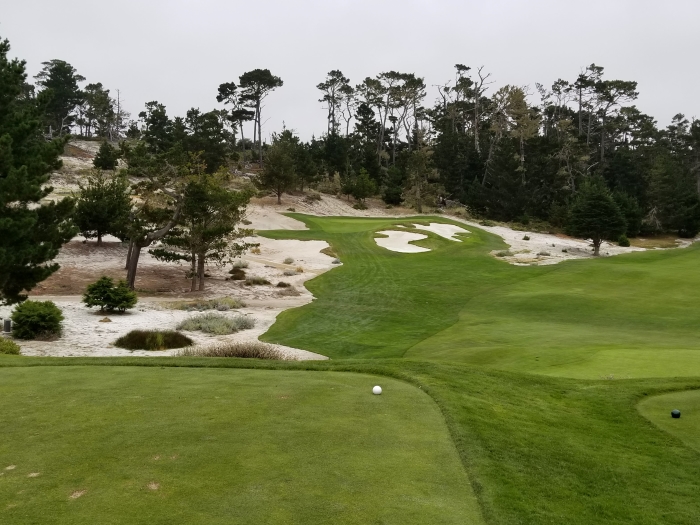
7th tee
LN (Bruno): Years ago when we sat down with fellow Penn Stater – Matt Shaffer (at Merion), he noted their “Heinz 57” varieties of turf, what’s the make-up of your surfaces here at CPC?
Markow: We do have several varieties in the natural areas, but that changes as you get to the playing areas. Uniformity, but out here it’s more about drought tolerance, water use – were slowly converting our fairways to bent. It’s a Poa golf course, but we’ve been fairly successful with the regulators changing the population to more predominantly bent. It’s a mix.
LN (Blasi) – Have you been seeding bent into it?
Markow: We’ve been cutting some fine fescue and bent into it. It’s a blend called PureFormance from tee to green. It has Crystal Blue Links in it and a few others like Pure Select/Pure Distinction. The greens are all Poa, maybe a bit of Bent but not much. We’re trying to be a little more homogenous in the rough – Rye/Fescue.
LN (Blasi): Water is the new gold (especially in California). Every course here with the exception of some in the Palm Springs area will have to be a desert course – Tees, fairway and greens with turf, everything else likely will be a natural area. Your thoughts?
Markow: Similar to what we have here, areas between tees and fairways are native or transition areas.
LN (Blasi): How much have you experimented with these areas and how challenging have those areas been?
Markow: We just let whatever mother nature brings up, so when we put the irrigation system in we did irrigate those areas in stretched spacing to keep the dust down. It’s California it stops raining in April and you don’t see rain again until November. So we run it just enough to keep the native stuff alive. It’s a strange site, thinking it would be sandy along the coast. We go over to Pebble where they have a really nice loamy type of soil, same thing up at SFGC, they have a nice sandy site. We have about four different types of soil, I think there was an old river that used to run through here, so some tight clays exist, then there’s a foot of topsoil. Then you get into the dune areas and there’s sand, but it’s capped with top soil. So we have a soil/sand Oreo type of mix.
LN (Blasi): When was that (when the soil capping took place)?
Markow: Dr.Mackenzie era – back then it was strange because you think links and sand growing areas, but they actually capped like 30 acres with top soil. Then we have what I call our Indiana farm soil out by the coast, a very dark native soil.
LN (Bruno): How much has that organic layer increased from nearly a century of golf agronomy over the club’s existence?
Markow: It’s not too bad, a little bit, we just keep aerifying, but I think everywhere you have organic matter it just keeps increasing – no matter what you do.
LN (Blasi): For the 2025 Walker Cup have they (USGA) asked you to alter any of your mowing patterns?
Markow: We haven’t really had any meetings yet. I don’t believe there’s going to be a lot of changes to the golf course. I was told we weren’t going to be adding tees or additional bunkers. I think the USGA will have control of the hole locations and green speeds, but not much else. Routing people in and out and logistics, lots to do on those issues.
LN (Blasi): It will be interesting to see if the players adapt to the design and architecture as the week goes on, just learning some of the nuance as the awe and wow factor fades during the week of competition.
Markow: If the wind comes up it’s a completely different golf course and challenge out here. Some of these kids may be at a disadvantage because they don’t play the ground game much. Lots of them just grab their 60 degree wedges, then they experience the ball spinning back at them. The overseas kids might have a slight advantage.
LN (Bruno): When was the last event here at the club that was open to spectators?
Markow: Probably ’89, before I arrived (it was actually ’91 At&t Pro Am). The club loves amateur golf and held up really well during some recent Stanford events held here and is excited to have the Walker Cup.
LN (Bruno): Do you expect that the USGA will be looking for firm & fast conditions?
Markow: For a few member events we try to give them a fairly firm and fast surface – quick greens and difficult pins, but the top amateur kids hit it so far today. Cameron Champ played out here and he just took it over the corner of the dune on No.8. There are some pin positions we can have to keep it interesting though. Walker Cup was here in ’81, since it’s match play, actual score is irrelevant. I don’t expect the teeing grounds to vary much.

par 3 – 15th
LN (Bruno): With such a diverse piece of property between the dunes and coastal holes, what is your biggest challenge here day in and day out?
Markow: I would say it’s water, because now it’s become a finite supply. We’ve basically had a 30% cut in our water supply without doing anything, and that has to be shared with six other courses on the peninsula. So we’re weather dependent, if we get our fall/spring rains we’re fine. We’ve had some dry winters where were irrigating and using the reservoir, that has to be replenished in the off-season. If that doesn’t happen, we start the season rationing. We’re fortunate that the membership enjoys the bounce and roll and some off-color turf.
LN (Blasi): What are your green profiles and which complexes are more challenging than others?
Markow: They’re original push-up greens, we pounded cores long-time ago, a sand top-dressing aerification layer from the 80’s and some black soil top dress for many years – below we have no idea what the Doc (MacKenzie) did down there (laughs). They drain fine, there’s a little organic matter in the surfaces. Hole 4 green is our most shaded green in the winter, 16 & 17 out on the water seem to accumulate more organic matter. Those two seem to have more thatch, so we’ll add some extra aerifications and verti-cutting on those two greens.
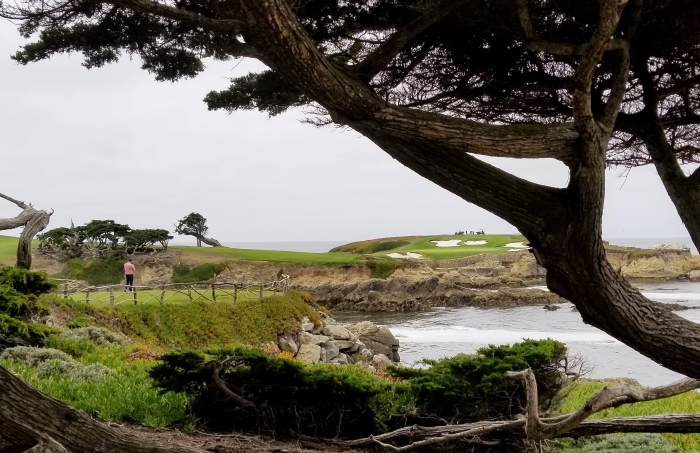
Jay Blasi soaking in the splendor of the 16th at CPC
LN (Bruno): What’s the size of your Agronomy staff?
Markow: We have right around 22 that includes two mechanics, two assistants and 3 interns. We’ve been fortunate with our labor situation in that we have two families that are part of our team – We’ve had a Grandpa, Dad and son all on staff at the same time, five of them actually. Another family is Uncle, brother, nephew and nephew. Some have been with us over 20 years.
LN (Blasi): How long did you have to close during the pandemic?
Markow: The clubhouse and pro shop closed but the members were able to play all the way through. No caddies, no flags and carry your own bag. We did close for a few days while the county was trying to figure things out early on. We had to cut the staff down to about half early on, but finally went back to full staff at the end of May.
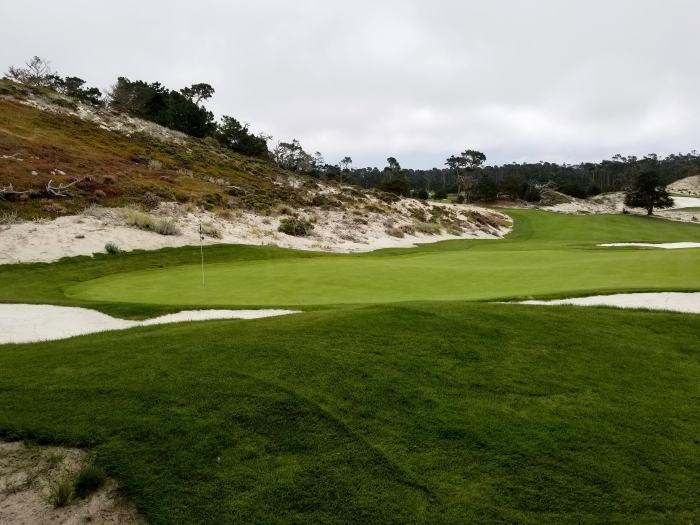
View from behind the 8th green
LN (Bruno): Everybody knows the two par 3’s on the ocean, but those that haven’t been on the property probably have no idea how special that section of dunes holes are, your thoughts . . .
Markow: Yes! We call that our little Amen Corner. You get to that tenth tee and think, OK, we survived. It’s just strategic. We’re doing some work up there, we took some bunker sand out and changed it into a dune and widened the fairway on nine and enlarged the ninth green a little bit.

9th tee
LN (Blasi): I think the ninth is one of the best holes in all of golf.
LN (Bruno): Totally agree, that entire section is incredible.
LN (Blasi): When you use old photos for reference, is there a specific year that you and the club target for the desired visual they want the course to be?
Markow: There’s a set, a collection of photos from the early 30’s – they contracted a photographer to walk with Mackenzie while he was playing. There’s images from all over the golf course, we have the full set. The club opened in ’28 and Dr. MacKenzie passed in ’34, so we know the time period. The early 30’s is the period we use to restore the course.
LN (Bruno): I’ve heard you mention Coore & Crenshaw being involved in some work prior to the Walker Cup, can you expound?
Markow: They are just fantastic people – not sure there’s enough words to describe how great it is to work with them. We have annual site visits with recommendations to improve the course and aesthetics. They have a natural, minimalistic approach and a wealth of knowledge.
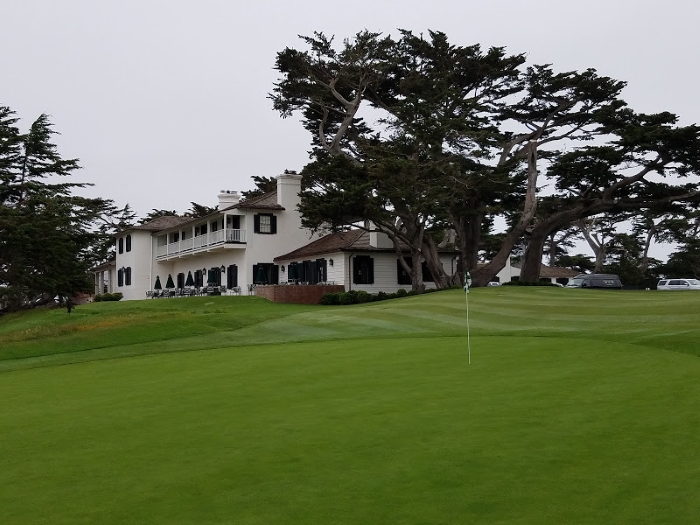
18 green and clubhouse
LN (Bruno): We are all envious, you have the best office on Earth, what’s the plan for Jeff Markow after Cypress Point?
Markow: I don’t know, I think I have a few things to offer the younger guys – if they’ll listen. Maybe some consulting or project management. Maybe back to Minnesota. I told Taylor (Taylor Anderson is the Assistant Superintendent at CPC) I’m going to come mow fairways for him wherever he ends up. Maybe just be a landscape guy – get outside and plant some flowers. . .

